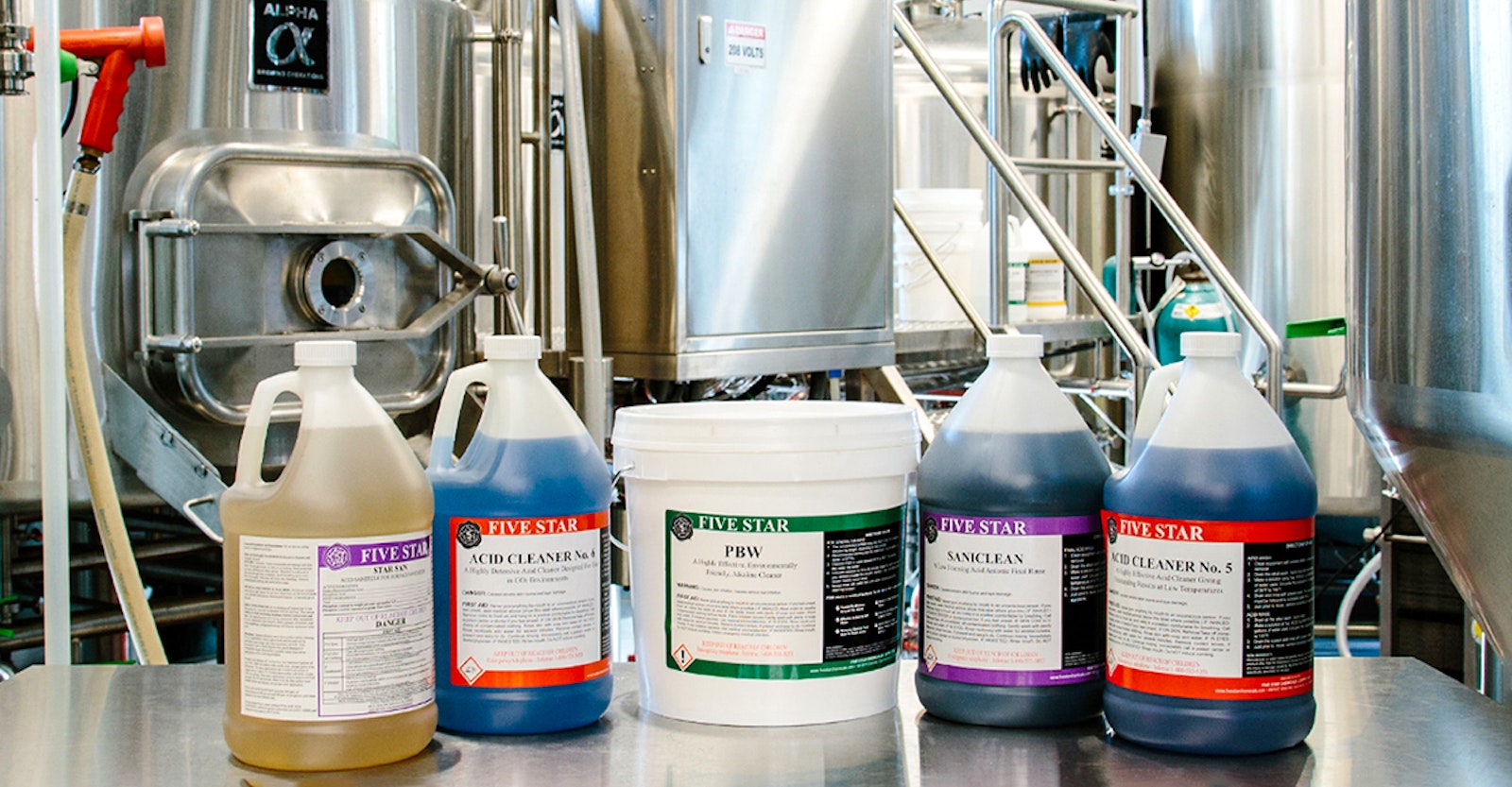SPONSORED CONTENT
There is no doubt that the craft beverage industry requires a lot of cleaning. When poorly executed, dirty equipment can be detrimental to your final product, causing off-flavors and breeding harmful bacteria. This is a big part of why cleaning remains one of the most important parts of the production process. That being said, it can be intimidating to navigate through all those different hoses and valves. Well, we’re here to help: The Five Star Three-Step Process will help you establish an effective cleaning routine.
While each piece of equipment is unique and may require different products, the Three-Step Process is a straightforward method that can be used on a wide variety of surfaces. Before we get into breaking it down, there are a few things to consider before you begin any cleaning procedure:
- Rinse before you start anything and between each step.
- Some equipment will require disassembly for smaller pieces to be cleaned separately.
- Cleaning will always yield the best results when done as soon as possible after use.
- Always follow the safety guidelines when handling chemicals.
- Clean all secondary tools, such as pitchers, buckets, and cylinders, in addition to the main equipment.
- Cleaning the exterior of equipment is just as important as the inside. Mold and bacteria can grow there too.
Step 1: Clean
When you are ready to start, we recommend using alkaline or caustic detergents to break down and remove residues. This step will eliminate oils, fats, and proteins when performed properly. This is especially true when you have things like hops, pulp, or yeast leftover from manufacturing.
- Alkaline detergents break down large proteins quickly and effectively. When used properly, they improve safety, usage costs, and reduce equipment corrosion. Our go-to alkaline cleaner is PBW, with its full-spectrum cleaning power. It is safe on all equipment and the environment. PBW also works at a wide temperature range and low concentrations, and it comes in powder, liquid, or tablet form.
- Caustic cleaners are unrivaled in their cleaning power. They can remove and prevent build-up while remaining effortless to rinse. There are also many precautions to take while using them. Caustic becomes hazardous when it comes into contact with skin and certain chemicals. The caustic cleaners that we recommend are Starline, Super CIP, or HD #2. Starline is non-foaming, free-rinsing, suited for CIP, and very effective in hard water. Star Super CIP removes protein stains at low concentrations with quick penetrations with low foaming surfactants. HD #2 is chelated for hard water tolerance and preventative scale formation.
Step 2: Acid Wash
While cleaning is useful for removing many heavy soils, the step is not effective against bacteria, water scale, or aluminum oxide. This is where the acid washing comes in. Acid-washing removes mineral build-up and organic materials from equipment.
- Phosphoric acid is used widely in the removal of heavy deposits on surfaces such as protein material resins and yeast. Its performance is greatly enhanced by adding an acid-stable surfactant, which assists in the rinsing process. We recommend using Food Grade Phosphoric Acid for washing tanks and neutralizing alkalis. It can also be used on copper kettles, but it is not effective until it reaches 60°F (16°C).
- For a more aggressive cleaner, we suggest using a nitric and phosphoric acid blend. Nitric acid is the most effective at removing scale and has biocidal properties. When mixed with phosphoric acid, the solution becomes more stable and less hazardous to handle. For a well-balanced blend, use Acid #5 or Acid #6 (for CO2 environments). The Acid #5 also provides the added benefit of re-passivating stainless steel surfaces. Nitric blends should not be used on soft metals, such as brass and copper, as they are corrosive.
Step 3: Sanitize
Sanitizing is extremely crucial to ensuring that a cleaning session is as efficient as it can be. This step prevents contaminants such as mold and bacteria from growing on equipment. It also only works on clean equipment that has been properly cleaned, rinsed, and dried. If sanitizing parts, put parts back on equipment wet to create a sanitary seal.
- Saniclean and Star San are anionic acids that work by creating a negative charge to attract positively charged bacteria. They are stable in hot or cold temperatures and work in the presence of organic matter. Anionic acids are non-corrosive to stainless steel but can be harmful to iron.
- StarXene is a stabilized chlorine dioxide that is non-corrosive to stainless and effective at low concentrations. It does not require a rinse when properly diluted and is odorless. It also needs direct acid activation prior to use.
- Io Star is an iodophor sanitizer that is fast-acting and non-selective. It is ineffective at high pH levels and can vaporize at 120°F (49°C), so extra care needs to be taken when using. It can also stain on skin, equipment, and clothing if not used correctly.
Following these steps, in order, will ensure that your craft beverage product is free from bacteria and stuck on grime. If you’re not sure which products are best for your set up, don’t hesitate to contact your chemical manufacturer.
SPONSORED CONTENT






